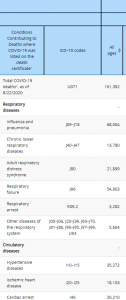
Anyone on the internet lately has seen the reports making the rounds about the CDC’s most recent comorbidity report for covid-19. It isn’t quite what people are saying. And it isn’t quite NOT what they are saying. Like most of life, not everything worth understanding can be communicated in a tweet or headline.

Here are a few things that are all true at the same time.
—Public policy making requires looking at statistics and numbers, but any death can be a tragedy at the individual level.
–Saying that only 6% of covid-19 coded deaths were ONLY attributable to covid is NOT the same thing as saying only 6% had covid-19 as a factor. It is clear that covid-19 is opportunistic and will strike more effectually where there is already a weakness. It is obviously true that some unknown number of people would still be alive if covid-19 wasn’t a thing, even factoring in comorbidities.
–In the case of some of these deaths, covid-19 was likely the cause of the comorbidity. Meaning that the person caught covid-19 first and that brought on the subsequent conditions: pneumonia, respiratory failure, etc.
–In the case of some of these deaths, the comorbidities were already there and covid-19 was just the final push that ended up causing their decline. I’m not a doctor (I don’t even get to play one on TV), but I’d guess that most of the comorbidities coded under the “Respiratory Diseases” category played some significant role—either as caused-by-covid or as a ‘final straw.’ Maybe many from the “Circulatory diseases” category as well.

–Some unknown number of people represented in the statistic died with covid-19, but covid-19 had nothing to do with their death. This is most obvious in the category for “Intentional and unintentional injury, poisoning, and other adverse events.”
The possible codes listed for these events run the range from vehicle accidents to assault to operations of war.
Here’s a non-inclusive sampling.

It is reasonable to assume that if you got killed in a car accident and happened to be covid-positive you probably should not be counted in the same way that we counted the others.
Another category I look a little sideways at is “Malignant neoplasms.” The ICD-10 codes C00-C97 are cancers of various types. Perhaps there are arguments to be made on a case-by-case basis, but it seems disingenuous to say that someone who has been battling, and subsequently (and sadly) died of, cancer is in-actuality a covid-19 death.
So what do all these true-at-the-same-time points mean taken all together?
For starters, the total number of deaths where covid-19 was the cause or significant contributor is very obviously more than the 6%.
It also is obviously less-than 100%, even if all you did was remove the “accidents” and “cancer” categories, which combine for 12,548 (as of this writing), or almost 8% of the total. (None of these are exclusive categories, though. A person could counted be in both. So maybe there is some unknown number of cancer patients who died in a car accident and who also were positive for covid.)
The problem is not those two categories in themselves, so much as what the inclusion of those categories says about the way these deaths are being counted in the first place. There is no distinction between death from covid versus death with covid.
Herein lies the frustration.
We know the upper limit (100% of the count) and the lower limit (6% of the count).
We also know that some unknown pile of deaths are death with covid simply due to the way that they are counting them, but we do not know what that number is. It could be “only” thousands, or it could be many tens of thousands.
If the former, the “CDC says 6%” headlines are maybe a non-story and within a certain margin of error that doesn’t make a significant difference.
If the latter, it is one more body of evidence that policy-makers have been making one tragic mistake after the next ever since this thing started.